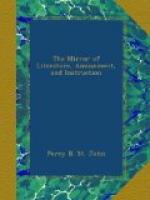* * * * *
COLEBROOK-DALE IRON-WORKS—THE REYNOLDS’.
(To the Editor of the Mirror.)
In the interesting extract you have given in your excellent Miscellany (No. 321) from Bakewell’s Introduction to Geology, when speaking of the exhausted or impoverished state of the iron-ore and coals in Shropshire, &c., an allusion is made in a note to that truly excellent man, the late Mr. Richard Reynolds, and to the final extinction of the furnaces at Colebrook-Dale, which is not altogether correct.
I beg leave, therefore, to point out the errors to you, and to add a fact or two more relating to that distinguished philanthropist and his family, which, perhaps, will not be unacceptable to many of your readers.
Mr. Reynolds was by no means the original, nor, I believe, ever the sole proprietor, of the iron-works in Colebrook-Dale, as stated by Mr. Bakewell; he derived his right in them from his wife’s family the Darbies; and the firm of “Darby and Company” was the well known mark on the iron from these works for a very long period; more recently, that of “Colebrook-Dale Company” was adopted.
The Darbies were an old and respectable family of the Society of Friends, and a pair of the elder branches of it were the original “Darby and Joan,” whose names are so well known throughout the whole kingdom. I had this anecdote from one of the sons of Mr. Reynolds,[7] and have no doubt of its authenticity.
It may not be generally known to your readers, perhaps, that the first iron bridge in England was projected at, and cast from, the furnaces of Colebrook-Dale, and erected over the Severn, near that place, about the year 1779; and, considering it to be the first bridge of the kind, I feel little hesitation in stating it to be, even now, the most beautiful one. This structure, at that time thought to be a wonderful attempt, was the entire offspring of Mr. Reynolds’ genius; it was planned, cast, and erected, under his immediate care and superintendance.




